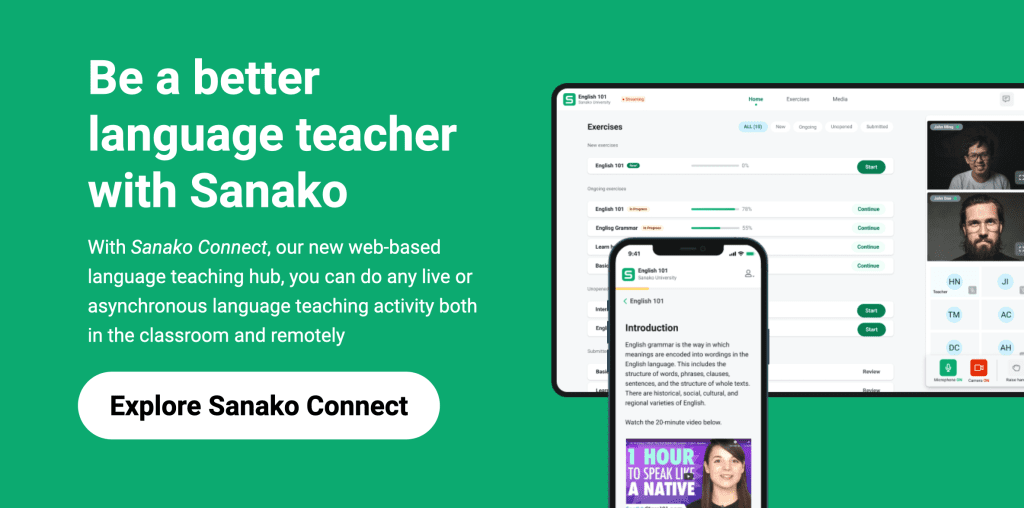There are few topics in education that divide opinion as much as homework. Yet there’s actually not that much coverage / research about the role of homework in language learning. Perhaps this suggests a general acceptance that it’s seen as a good thing despite the additional work involved for educators and students?
However, it is important to reiterate that simply setting homework because it’s school policy or because educators have to, is unlikely to be effective or improve learning outcomes in the long term. Homework, like every lesson delivered in class, clearly needs to be carefully tailored to the students doing it, particularly given the wealth of resources now available to students online.
This blog post therefore looks at both sides of the argument for setting homework for language students. It then looks at the characteristics of effective homework and suggests some types of homework for you to try!
Why is setting homework for language learners a good thing?
A good place to start this post is to look at the rationale for giving language learners homework. And the first and most obvious reason is that it increases the amount of time each student gets to spend with the target language and working through the topics covered in class. This is vital for language learners, who need to build up reading, writing, speaking and listening skills that may not receive sufficient time / focus in the classroom.
Importantly, homework can also provide continuity between lessons. This not only helps to consolidate what’s been done in class, but can also help students prepare themselves for what’s to come. Furthermore, homework can also provide a “home” for many of the repetitive and time-consuming elements of language learning such as learning vocabulary using flashcards or prepping for a speaking task. This helps free up time for more language production time in class.
Moreover the majority of language students will be learning in their own time and for their own reasons. Some students will have the motivation to complete the course, but others will need a regular push to keep working on their language skills. Setting homework is a good way to keep them learning and serves as a reminder that putting in the time is a crucial component of second language learning success.
For all students, time spent expanding their knowledge and understanding outside of the class also helps learners to identify gaps in their knowledge. Or areas of misunderstanding, where additional work or clarification by the language teacher is required.
What are the disadvantages of homework?
Despite these clear benefits, there are also vocal advocates who argue that homework is actually not a good thing. Although it’s worth stressing that usually their evidence is based on homework generally rather than specifically in language learning settings. Actually the one quite often cited research paper focusing on homework and foreign language learning concludes that “there was little evidence to indicate that homework either contributed to or detracted from the language‐learning process.”
Unsurprisingly, both students and parents consider homework to be a significant stress factor in their homes. Many families go further arguing that time spent doing homework reduces the amount of family time available or the time children spend on social or leisure pursuits.
Taking teachers as a whole, it’s clear that the profession has mixed feelings about homework. Despite the obvious advantages, it’s a source of contention with many students. Whilst marking and providing feedback is a significant drain on teachers’ time, often taking place after school or at the weekend.
Of course, few students love doing homework, but available research suggests that much of their frustration stems from what they are being asked to do. Too often the work set is seen as boring or unrelated to the topics being studied in class.
So with that in mind how can language educators set more engaging and effective homework tasks?
Setting effective homework for second language learners
In order for homework to be effective, there are a few common principles that can be applied.
- Students should always see the usefulness of homework – make it clear what the objective is and how it relates to work that they have done in today’s class or are about to do in the next class.
- The homework should be clearly explained – too often students spend ages trying to work out what it is they are supposed to be doing. Always provide clear instructions and clear expectations for your language learners!
- All tasks set should be relevant, interesting and varied – sounds obvious, doesn’t it? And don’t forget to include a mix of media / formats in both stimulus and response. Homework doesn’t always need to be rote learning based on reading, writing or fill-in-the-blanks activities!
- Homework should be manageable in terms of time as well as level of difficulty – it’s fine to stretch students but all tasks should be achievable within a reasonable period of time. No all-nighters anymore please!
- Different tasks may be assigned to different ability groups – tailor the homework to the student, whilst considering their competence level and any preferred learning styles. As tailoring homework per student can definitely be too time-consuming for the teachers, one solution is to create variations (eg. options A, B and C or options for Reading, Speaking, Writing, etc.) and allow the students to select which variation they prefer to do for the next class.
- Don’t just focus on setting written assignments – yes they’re easier to review but give equal priority to developing the other core language skills as well. Educational tech tools such as Sanako Connect can easily be used to create effective and fun listening and speaking homework activities.
- Homework is not school work – take advantage of this and offer opportunities for students to produce / use real-life language content.
- Homework should always contain opportunities for assessment and feedback – there’s no greater demotivator for students than doing homework which is never marked. This is vital for language learning as uncorrected mistakes tend to stick and become habits. Always acknowledge the time, effort and hard work that students have put in to complete their homework. Oh and don’t forget that peer review or self-assessment can also be useful ways of reviewing work and building students’ confidence at the same time!
Types of homework for language learning
For many of the reasons outlined above, it’s impractical and probably irrelevant for us to suggest specific homework tasks for educators to set. But we hope that this rapid review of potential task types might provide some inspiration.
1. Flipped classroom
This learner-centred approach called the flipped classroom method introduces students to new topics outside of school (e.g. watch this online video, read this chapter) which frees up classroom time for more in-depth discussion or exploration related to the reviewed material. For language learners, this could mean that homework is an opportunity to practise skills, so that class time is then spent reviewing, speaking and engaging in problem-solving activities.
2. Preparation tasks
Homework can be a powerful way of exciting students about what’s coming next. Give them the time to read ahead and maybe encourage them to produce language content that brings the next topic to life. For example, could they create a film about their family or do a presentation about their favourite holiday destination?
3. Real-world language
Such tasks focus on setting their L2 within a realistic context. Reading magazines, watching Netflix, talking to a native speaker or listening to music are obvious examples. Explore how these tasks can be made into active learning opportunities – get students to record a video reviewing what they’ve seen or writing a diary / summary of conversations they’ve had.
4. Surprise me homework
This is a firm favourite for teachers on social media. In essence, students are given free rein to apply their learning to a homework project, which allows their creative passions to come to the fore. As this advocate argues: “You never know what you are going to get and that is just so exciting! It’s wonderful to see the awesome ingenuity of students and the connections they have made to their hobbies, passions and free time activities linking this with MFL.”
Whatever homework you want students to work through, you’ll need a tailored online tool to share the stimulus material and homework activities and make it super easy for students to submit their responses. Sanako Connect is the perfect online language teaching hub for the job as it’s a virtual classroom system designed for language educators. It allows them to seamlessly share files and materials, run live and asynchronous classes, and share homework. Educators can also collect, review and feedback on students’ work – all on the same easy-to-access online platform.
If you’d like to find out how Sanako Connect supports language teachers and students, click the banner below to learn more and book your free online demonstration.

